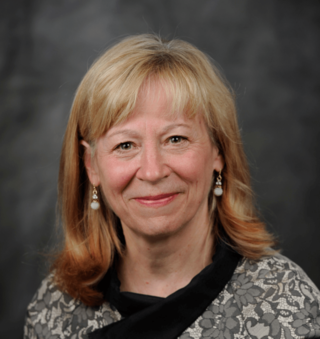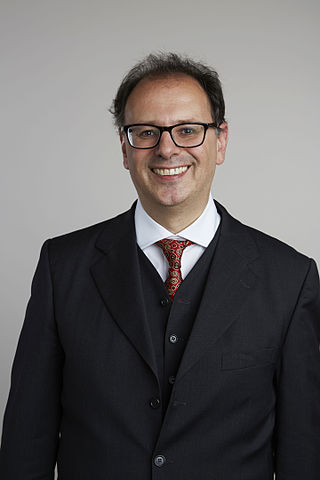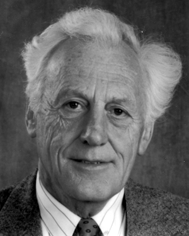Related Research Articles

In chemistry, an ionic compound is a chemical compound composed of ions held together by electrostatic forces termed ionic bonding. The compound is neutral overall, but consists of positively charged ions called cations and negatively charged ions called anions. These can be simple ions such as the sodium (Na+) and chloride (Cl−) in sodium chloride, or polyatomic species such as the ammonium (NH+
4) and carbonate (CO2−
3) ions in ammonium carbonate. Individual ions within an ionic compound usually have multiple nearest neighbours, so are not considered to be part of molecules, but instead part of a continuous three-dimensional network. Ionic compounds usually form crystalline structures when solid.

Donald Lynden-Bell CBE FRS was a British theoretical astrophysicist. He was the first to determine that galaxies contain supermassive black holes at their centres, and that such black holes power quasars. Lynden-Bell was President of the Royal Astronomical Society (1985–1987) and received numerous awards for his work, including the inaugural Kavli Prize for Astrophysics. He worked at the University of Cambridge for his entire career, where he was the first director of its Institute of Astronomy.

An ionic liquid (IL) is a salt in the liquid state. In some contexts, the term has been restricted to salts whose melting point is below a specific temperature, such as 100 °C (212 °F). While ordinary liquids such as water and gasoline are predominantly made of electrically neutral molecules, ionic liquids are largely made of ions. These substances are variously called liquid electrolytes, ionic melts, ionic fluids, fused salts, liquid salts, or ionic glasses.

Denis James Evans, is an Australian scientist who is an Emeritus Professor at the Australian National University and Honorary Professor at The University of Queensland. He is widely recognised for his contributions to nonequilibrium thermodynamics and nonequilibrium statistical mechanics and the simulation of nonequilibrium fluids.

In the context of chemistry and molecular modelling, a force field is a computational method that is used to estimate the forces between atoms within molecules and also between molecules. More precisely, the force field refers to the functional form and parameter sets used to calculate the potential energy of a system of atoms or coarse-grained particles in molecular mechanics, molecular dynamics, or Monte Carlo simulations. The parameters for a chosen energy function may be derived from experiments in physics and chemistry, calculations in quantum mechanics, or both. Force fields are interatomic potentials and utilize the same concept as force fields in classical physics, with the difference that the force field parameters in chemistry describe the energy landscape, from which the acting forces on every particle are derived as a gradient of the potential energy with respect to the particle coordinates.

Daan Frenkel is a Dutch computational physicist in the Department of Chemistry at the University of Cambridge.
Dame Lynn Faith Gladden is the Shell Professor of Chemical Engineering at the University of Cambridge. She served as Pro-vice-chancellor for research from 2010 to 2016.

Michael Lawrence KleinNAS is Laura H. Carnell Professor of Science and Director of the Institute for Computational Molecular Science in the College of Science and Technology at Temple University in Philadelphia, USA. He was previously the Hepburn Professor of Physical Science in the Center for Molecular Modeling at the University of Pennsylvania. Currently, he serves as the Dean of the College of Science and Technology and has since 2013.
Martini is a coarse-grained (CG) force field developed by Marrink and coworkers at the University of Groningen, initially developed in 2004 for molecular dynamics simulation of lipids, later (2007) extended to various other molecules. The force field applies a mapping of four heavy atoms to one CG interaction site and is parametrized with the aim of reproducing thermodynamic properties.
Frank H. Stillinger is an American theoretical chemist and a namesake of the Lubachevsky–Stillinger algorithm. He has recently collaborated with research groups as a Senior Scientist at Princeton University.

Geraldine Lee Richmond is an American chemist and physical chemist who is serving as the Under Secretary of Energy for Science in the US Department of Energy. Richmond was confirmed to her DOE role by the United States Senate on November 5, 2021. Richmond is the Presidential Chair in Science and Professor of Chemistry at the University of Oregon (UO). She conducts fundamental research to understand the chemistry and physics of complex surfaces and interfaces. These understandings are most relevant to energy production, atmospheric chemistry and remediation of the environment. Throughout her career she has worked to increase the number and success of women scientists in the U.S. and in many developing countries in Africa, Asia and South America. Richmond has served as president of the American Association for the Advancement of Science, and she received the 2013 National Medal of Science.

Ali Alavi FRS is a professor of theoretical chemistry in the Department of Chemistry at the University of Cambridge and a Director of the Max Planck Institute for Solid State Research in Stuttgart.

John Norman Murrell FRS was a British theoretical chemist who played a leading role in revolutionising the UK's reputation for theoretical chemistry during the second half of the 20th century.

Klaas Wynne is a Professor in the School of Chemistry at the University of Glasgow and chair of Chemical Physics. He was previously a professor in the Department of Physics at the University of Strathclyde (1996–2010).
Florian Müller-Plathe is a German theoretical chemist and professor for theoretical physical chemistry at Technische Universität Darmstadt.

Branka Maria Ladanyi was a physical chemist, who spent her career in the Department of Chemistry at Colorado State University. Her research focused on structure and dynamics of liquids, broadly defined, which she studied using theoretical and computational techniques.

Amalie L. Frischknecht is an American theoretical polymer physicist at Sandia National Laboratories in Albuquerque, New Mexico. She was elected a fellow of the American Physical Society (APS) in 2012 for "her outstanding contributions to the theory of ionomers and nanocomposites including the development and application of density functional theory to polymers". Her research focuses on understanding the structure, phase behavior, and self-assembly of polymer systems, such as complex fluids polymer nanocomposites, lipid bilayer assemblies, and ionomers.

Elena Besley is a British scientist who is Professor of Theoretical and Computational Chemistry at the University of Nottingham. She holds a Royal Society Wolfson Fellowship and is Associate Editor of Nano Letters.
Stephen J. Smartt is an astrophysicist from Northern Ireland who specialises in stellar evolution, supernovae and time domain sky surveys. He is credited with the discovery of stars that explode as supernovae, measuring their mass, luminosity and the chemical elements synthesized. Smartt is a Professor of Astrophysics at the School of Mathematics and Physics at Queen's University Belfast. He is a patron of Northern Ireland Humanists.
Susan Perkin is a British chemist who is a Professor of Physical Chemistry at the University of Oxford. Her research considers the physics of liquids and soft matter. She was awarded the 2016 Harrison-Meldola Memorial Prize and named the Soft Matter Lecturer of 2018. In 2015 Perkin was awarded a European Research Council starting grant and in 2020 she was awarded a European Research Council consolidator grant.
References
- 1 2 3 "'LYNDEN-BELL, Ruth Marion', Who's Who 2013, A & C Black, an imprint of Bloomsbury Publishing plc, 2013; online edn, Oxford University Press, Dec 2012".(subscription required)
- 1 2 3 "Fellows of the Royal Society | Royal Society" . Retrieved 7 January 2013.
- 1 2 3 "Women in Chemistry, Ruth Lynden-Bell | Department of Chemistry". www.ch.cam.ac.uk. Retrieved 7 August 2018.
- ↑ Lynden-Bell, Ruth M. (20 April 2021). "My Life in Changing Times: New Ideas and New Techniques". Annual Review of Physical Chemistry. 72 (1): 35–50. doi:10.1146/annurev-physchem-090319-054423. ISSN 0066-426X . Retrieved 26 January 2022.
- ↑ (19 May 2006). Royal Society Elections, University of Cambridge , Department of Chemistry, Theoretical Chemistry News Page. Retrieved 2 December 2010
- ↑ Awards to Individuals 2003, Leverhulme Trust . Retrieved 2 December 2010
- ↑ "Google Scholar".
- ↑ Ruth Lynden-Bell publications indexed by Microsoft Academic
- ↑ Del Pópolo, M. G.; Lynden-Bell, R. M.; Kohanoff, J. (2005). "Ab Initio Molecular Dynamics Simulation of a Room Temperature Ionic Liquid". The Journal of Physical Chemistry B. 109 (12): 5895–5902. doi:10.1021/jp044414g. PMID 16851642.
- ↑ Lynden-Bell, R. M.; Del Pópolo, M. G.; Youngs, T. G. A.; Kohanoff, J.; Hanke, C. G.; Harper, J. B.; Pinilla, C. C. (2007). "Simulations of Ionic Liquids, Solutions, and Surfaces" (PDF). Accounts of Chemical Research. 40 (11): 1138–1145. doi:10.1021/ar700065s. PMID 17914887.
- ↑ Pinilla, C.; Del Pópolo, M. G.; Lynden-Bell, R. M.; Kohanoff, J. (2005). "Structure and Dynamics of a Confined Ionic Liquid. Topics of Relevance to Dye-Sensitized Solar Cells". The Journal of Physical Chemistry B. 109 (38): 17922–17927. doi:10.1021/jp052999o. PMID 16853300.
- ↑ Honorary Degree information from Queen's University Belfast
- ↑ Torney, Kathryn (6 July 2009). Queen's University of Belfast Graduations, The Belfast Telegraph . Retrieved 2 December 2010 ("Queen's University professor Emerita Ruth Lynden-Bell will be awarded Doctorates of Science for distinction in chemistry at a ceremony tonight.")